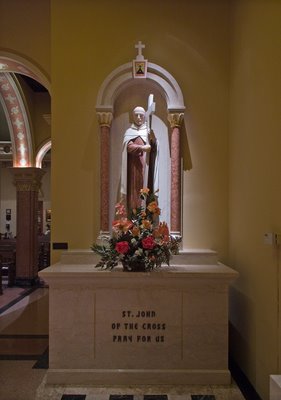HERE ARE PHOTOGRAPHS of Old Saint Ferdinand's Shrine, in
Florissant, Missouri, which is 17 highway miles northwest of downtown Saint Louis. This is perhaps the oldest church in the Louisiana Purchase territory, dating from 1819. This was the home of the missionary
Saint Rose Philippine Duchesne (29 August 1769 - 18 November 1852), co-foundress of the
Society of the Sacred Heart in the U.S., who was known to the Pottowatomi Indians as the "
Woman-Who-Prays-Always".
Mother Duchesne was declared venerable in 1900, beatified in 1940, and canonized in 1988.

On Saturday, December 9th, 2006, the
Canons Regular of the New Jerusalem hosted a
conference at the shrine, followed by Vespers and Compline.

This altar dates from 1870.

Crucifixion painting and the sanctuary light next to the altar. These photos are fuzzy and grainy because I didn't use a tripod to stabilize the camera.

Sacred Heart of Jesus above the altar.

Statues of an angel and
Saint Ferdinand III, King of Leon and Castile (1198 - 1252), whose life goals were the propagation of the Faith and the liberation of Spain from the Saracens.

Under the altar is a wax effigy, containing relics of Saint Valentine, Roman martyr, from A.D. 270. As a young child visiting this church, I was horrified by this
dead body under the altar, and to make it worse, it was the Saint of Valentine's Day greeting card fame!

The
Second Gospel,
John 1, on the altar.

The tabernacle. This church remains consecrated, and Mass is occasionally celebrated, but the Blessed Sacrament is not reserved here.

Baptismal font.

An indulgenced Mission Crucifix, provided by the Jesuits. I think it was this crucifix that made me realize, as a young child, that Christ was executed by the Romans: earlier I thought that the Romans were schoolyard bullies, and had just tied him to the cross. Yeah, I was dumb kid.

Station of the cross.

A painting in the church. I'm not sure who is this Saint. [UPDATE - a reader commented: "The saint that you didn't know was St. Cecelia. She was martyred in Rome and was found in that position when she died. One finger extended in one hand for one God and the three fingers extended in the other hand symbolizing the Trinity."]

Painting of the Blessed Virgin Mary

1792 SESQUI-CENTENNIAL 1942.
An American serviceman holding the flag, next to a plane with the words "IN GOD WE TRUST", shakes hands with a priest with the Vatican flag. while Saint Ferdinand looks on.

A model of how the church looked when first constructed. The logs are now covered by brick and plaster.

Detail of the ceiling, curved, and made out of strips of wood like a barrel .

The pipe organ in the loft.

A view of the nave. Note the ornate crystal chandeliers.

Where a transept may be in an ordinary church, are here instead doors into the side-buildings. This is a doorway into the rectory; now a museum and gift shop; on the other side is a door to the convent. Above the doors are archways to the second story of the buildings, allowing a view into the sanctuary.

The museum has a collection of dolls in historical nuns' habits. The loss of the habit after the Second Vatican Council seems to have led to a loss of identity in some religious orders.


Statues in the museum.

Holy medals.

Mother Duchesne used this confessional for years.



These are old tabernacles used in this church, dating from 1789, 1821, and 1832. E.V.S.O.D. stands for
Ego Vobiscum Sum Omnibus Diebus "I am with you all days" (
Matthew 28:20).
The adjoining
Convent
was built for
Mother Rose PhilippineDuchesneof
The Society of the Sacred Heartin 1819-1820by
Father
De
La
Croix
+Mother Duchesnelived here for many years
teaching the children of the early
settlers and instructing the
Indian children.
Laboring amidst great privations
to establish Christianity in
a
New
Land.
 BlessedRose PhilippineDuchesne
BlessedRose PhilippineDuchesneCo-foundress of the
Society of theSacred Heartin the
United States
arrived in the village of
St. Ferdinand de Fleurissant
December 21, 1819

Mother Duchesne slept here,
in a closet, under the stairs.

The faithful leave prayer intentions in the Saint's tiny bedroom.

Old processional cross and
incensorium.

The convent's kitchen.

Dormitory on the second floor of the convent.

My guide said that the convent's garret is scary, even in the daytime.

Parlor of the convent.

Devotional cabinet of Blessed (now Saint) Philippine Duchesne.

The front door of the church, with Christmas lights.
Click here for older exterior photos of the shrine.Newer photos of the shrine can be found
here and
hereAddress:1 Rue St. François
Florissant, MO 63031







































 TODAY IS THE FEAST DAY of Saint John of the Cross (June 24, 1542 – December 14, 1591), Spanish Carmelite friar, mystic, and Doctor of the Church. Along with fellow mystic and Doctor, Saint Teresa of Ávila, John founded the reform order of Discalced Carmelites. (Photo taken in the Discalced Carmelite Monastery in Saint Louis County, Missouri.)
TODAY IS THE FEAST DAY of Saint John of the Cross (June 24, 1542 – December 14, 1591), Spanish Carmelite friar, mystic, and Doctor of the Church. Along with fellow mystic and Doctor, Saint Teresa of Ávila, John founded the reform order of Discalced Carmelites. (Photo taken in the Discalced Carmelite Monastery in Saint Louis County, Missouri.)